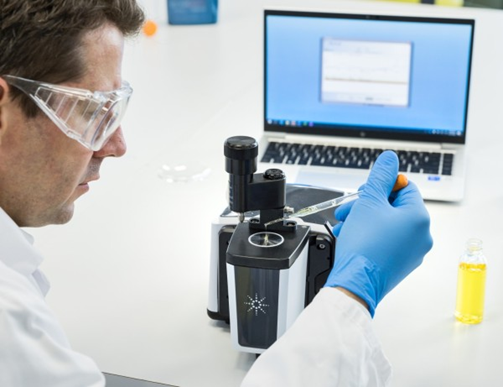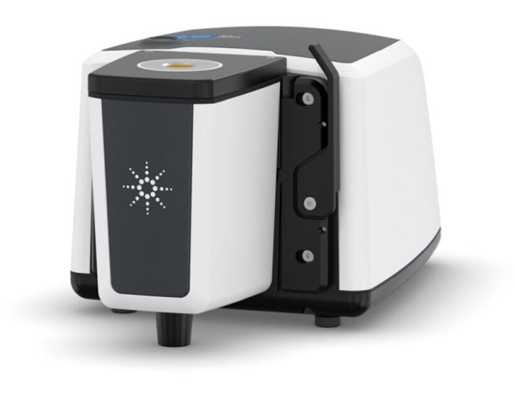
Previously, on the Molecular Spectroscopy blog
In part 1 of this series, we discussed which Cary 630 FTIR Sampling Technologies are best suited for most routine experiments. We’ll now take a look at more exotic experiment setups and see how the Cary 630 FTIR is most certainly apt for these as well. We’ll also check out which Sampling Technologies can produce the best quality signals in these instances.
Highly concentrated liquid analysis
We lightly touched on this point in Part 1 of this series, but now let’s dive into a few more of the technical details. The DialPath and TumblIR can be fitted with pathlengths as low as 30 um, which in general is sufficient for most liquid samples. However, for some highly concentrated samples, a 30 um pathlength might still be too long, which may result in detector saturation. Attenuated total reflectance (ATR) comes to the rescue once again, with the concept of sample penetration depth making a return. The diamond ATR has a much lower sample penetration depth (¬2 um) compared to a 30 um pathlength and is an excellent choice for highly concentrated liquids. Simply pipette a drop onto the ATR stage for analysis, and that’s it! There is no need to close the ATR press when analyzing liquids, as this is only required to ensure good contact with solids.

Rubber-based solid compounds, solids very dark/black in color, thermo-elastic polymers, and any other highly absorbing solid media
The diamond ATR sampling technology can generally handle most samples with ease. Rubber-based or very dark samples can however pose a challenge due to their highly absorbing nature. In this case, the germanium ATR is the preferred sampling technology, owing to its much smaller sample penetration depth (¬0.5 um) compared to diamond (¬2 um).
The smaller penetration depth of the light going through a germanium crystal allows even the most highly absorbing samples to be easily analyzed, as less intense signals are produced. A word of caution here however; germanium is much softer than diamond, so extra care should be taken when handling and cleaning this ATR accessory.
When ATR pathlengths are too short, and DialPath pathlengths are too long
There are some unique applications which require pathlengths somewhere between ATR and other accessories, such as the DialPath module. One could of course resort to a liquid cell using the Transmission module, however as previously discussed, liquid cells can be quite fiddly and have issues with air bubble formation. Here’s where the Zinc Selenide Multibounce ATR Sampling Technology really shines. This module reflects the light back multiple times onto the sample, thereby greatly increasing the signal intensity of analysis. As this module is primarily designed for liquids, there is no pressure press, it is merely necessary to pipette the sample on the stage and proceed with analysis. This module is featured most prominently in the biodiesel application for ASTM 7371 and EN 14078, but is applicable to many other scenarios as well.

Analyzing reflective materials and surface coating materials
Many scientific applications require coated surfaces, but these can sometimes be very challenging to characterize due to their thin nature. Two options exist depending on the nature of the sample and its intended application. If the sample is a flat, polished, highly reflective material (i.e., a mirror or other optical component), the 10 Degree Specular Reflectance Sampling Technology would be the preferred option. With this Sampling Technology, the sample simply rests on top of the module, reflective side down, for making measurements. For flat samples with coatings, a 45 Degree Specular Reflectance accessory exists for the Transmission Sampling Technology which might be the best approach. The slightly steeper incident angle of light hitting the sample will allow for a bit more interaction with the coating, rather than the substrate underneath. Highly polished materials can also be measured on the 45 Degree Specular Reflectance module if their intended use involves non-normal angles of incidence.

As with many solid analyses, there are exceptional cases (such as coatings analyzed at 10 degrees rather than 45 degrees) but most straight-forward solid sample analyses fall into the above categories.
If the coating is very thin (i.e., less than 1 um in thickness), it may be preferred to use our excellent battery- powered 4300 Handheld FTIR with Grazing Angle Sampling Technology. This accessory has an incredibly steep 82-degree angle of incidence, which greatly lengthens the surface over which light coming from the instrument interacts with the coating (effectively increasing the “pathlength” of coating analyzed).
In conclusion, the Cary 630 is indeed most versatile
As we’ve seen in this 2-part series, the hot-swappable modular nature of the Cary 630 definitely lends itself to a wide variety of applications. In addition, no realignment is necessary when switching Sampling Technologies, meaning experiments can be changed almost instantly without fear of data quality loss from poor accessory alignment. The MicroLab software will automatically recognize each Sampling Technology when inserted, further eliminating any complexity involved in swapping tasks.
Further reading
- Technical overview: Basics of FTIR Spectroscopy
- Technical overview: Basics of ATR-FTIR Spectroscopy
- Technical overview: Basics of Transmission FTIR Spectroscopy
- Technical overview: Guide to FTIR Analysis and FTIR Applications
- Application note: ASTM D7806-12 for Biodiesel in Petroleum-based Diesel Fuel Oil
- Application note: Pharmaceutical Packaging Materials Quality Control and USP Chapter <661.1> Compliance
- Application note: Quick and Easy Material Identification of Salts Used in Lithium-Ion Batteries by FTIR
- Application note: Material Identification of Plastics Throughout Their Life Cycle by FTIR Spectroscopy
Molecular spectroscopy webinar series
Get the latest product information and lots of helpful tips and tricks from our frequent molecular spectroscopy webinars. These live and interactive sessions take place every week, with all previous sessions available to watch on-demand.
Got a question? Leave a note on the comments below or send your query directly to our expert spectroscopy team.
